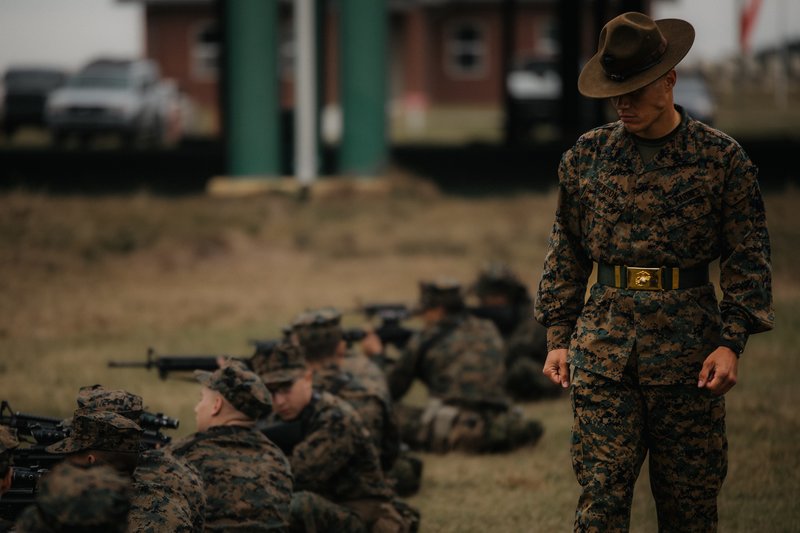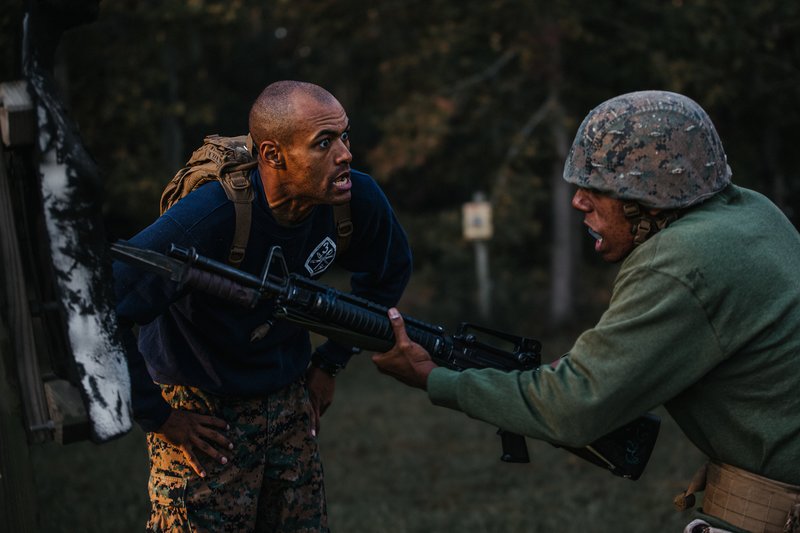7 Things You Never Knew About Marine Corps Recruit Depot Parris Island

The campaign cover is an item worn by drill instructors that hold the responsibility of transforming men and women into the next generation of Marines. US Marine Corps photo by Lance Cpl. Roxanna Gonzalez.
Parris Island has been home to Marine Corps recruit training since 1915. Nestled amid the alligator-infested swamps of the South Carolina lowcountry, just 40 miles northeast of Savannah, Georgia, it is the second oldest post in the Corps. More than 1 million recruits have attended boot camp there, enduring sweltering temperatures, sand fleas, and the wrath of the world’s most notorious drill instructors to become Marines.
For all its fame, Parris Island retains an aura of mystery. New enlistees first arrive on the island in the middle of the night. They are carted in on buses and ordered to keep their heads between their knees, until a drill instructor climbs aboard and screams for them to get off. They don’t sleep or see daylight for the next 24 hours, during which their heads are shaved, their uniforms are issued, and their minds race, trying to remember why they decided to join the Marine Corps instead of going to college. The training lasts 13 weeks.

US Marine Corps drill instructor Sgt. Antonio L. Aranda yells orders at recruits of Kilo Company, 3rd Recruit Training Battalion, to put on their masks before entering the gas chamber July 25, 2017, on Parris Island, South Carolina. US Marine Corps photo by Lance Cpl. Joseph Jacob.
It is not until after recruits graduate boot camp and are free to venture beyond the watchful eye of their drill instructors that they are finally able to see that Parris Island is, in fact, an actual island. Surrounded by the waters of the Port Royal Sound, it is an 8,000-acre land mass of swamps, saltwater creeks, and oak thickets draped in Spanish moss. Only 3,000 acres of the island are dry land.
Here are seven more things you probably didn’t know about Parris Island.
Parris Island Was One of the Earliest European Settlements in North America
For more than 6,000 years, the island was inhabited by the Mississippians, a Native American tribe whose villages spanned the Southern United States. Then, in 1562, French explorers arrived on the island and built a small outpost. It was the first semi-permanent European settlement in what is now the United States, established three years before the Spanish founded the town of St. Augustine and 45 years before the English arrived in Jamestown.

For one week, recruits learn and practice the fundamentals of marksmanship before shooting live ammunition the following week. US Marine Corps photo by Lance Cpl. Maximiliano Bavastro.
A few centuries later, as the United States military was gearing up for the First World War, Parris Island was transformed into a training center for Marines. The site was selected for its rare deep-water harbor and also because it offered more than enough uninhabited land that could be used for training entire battalions of men. The space eventually proved necessary. These days, 20,000 recruits attend boot camp on the island every year.
The Attack on Pearl Harbor Caused a Recruit Training Overhaul
On Dec. 7, 1941, the day Japan attacked Pearl Harbor, there were only 2,869 recruits training on Parris Island. Two months later, after the US declared war on Japan and lowered its military enlistment age from 18 to 17, that number swelled to approximately 15,000. The recruit depot was renovated and expanded to accommodate the dramatic influx of recruits, which required the Corps to construct more than 300 new Quonset huts on the island. Also, because time was of the essence, the duration of training was temporarily cut in half, going from eight weeks to four. Today, recruit training is 13 weeks.

Conditioning hikes, like this six-mile hike, prepare recruits for the physical demands of the Crucible. US Marine Corps photo by Lance Cpl. Joseph Jacob.
Drill Instructor School Was Created Because of the Korean War
Parris Island underwent another significant expansion during the Korean War. When the conflict began in June 1950, the island was home to just three training battalions, each comprising approximately 1,400 recruits. By the end of that year, five more battalions had been added. Of course, more recruits necessitated more drill instructors to train them. So, in 1952, the Corps established an official drill instructor school on Parris Island. The original curriculum entailed three and a half weeks of training. Today, the course is 11 weeks long.

Recruits with Echo Company, 2nd Recruit Training Battalion, maneuver through obstacles during the Crucible on Marine Corps Recruit Depot Parris Island, South Carolina, May 19, 2023. US Marine Corps photo by Lance Cpl. Ava Alegria.
The Drill Instructors Creed Was Created After Six Recruits Drowned
On April 8, 1956, a Marine drill instructor led his platoon of recruits on an unauthorized night march through the swampy backwoods of Parris Island. During the hike, the platoon followed the bank of one of the island’s many creeks. Six recruits strayed into deep water and drowned. The drill instructor later admitted to being drunk and was convicted of negligent homicide. As a result of the incident, the Marine Corps established the drill instructors creed, a four-sentence oath codifying the drill instructor’s responsibility to ensure the safety of their recruits. It reads:
“These recruits are entrusted to my care. I will train them to the best of my ability. I will develop them into smartly disciplined, physically fit, basically trained Marines, thoroughly indoctrinated in love of the Corps and country. I will demand of them and demonstrate by my own example, the highest standards of personal conduct, morality and professional skill.”

The yellow footprints are traditionally the first direction that new recruits receive when first arriving at Parris Island. US Marine Corps photo by Sgt. Alexa M. Hernandez.
The Iconic Yellow Footprints Didn’t Exist Until the Vietnam War
Every Marine begins their journey on a set of yellow footprints. The rows of painted footprints mark where new enlistees stand in formation when they first set foot on Parris Island. They are also meant to teach recruits how exactly to place their feet when standing at the position of attention.
Given how synonymous the yellow footprints have become with the boot camp experience, Marines might assume that they have existed since the dawn of time. That is not the case, however. In fact, the first footprints were not painted on Parris Island until 1965.
Parris Island Has a Pet Cemetery Filled With Bulldogs
From the wreckage of a World War II-era plane that crashed on the island in 1943 to a chapel with Iwo Jima–themed stained-glass windows, relics of the Marine Corps’ storied past can be found all over Parris Island. Perhaps the strangest historical landmark on the island is a pet cemetery.

US Marine Corps Sgt. William Carrasquillo encourages Rct. Deshawn Natsuyama, Platoon 3006, Kilo Company, 3rd Recruit Training Battalion, to move faster during bayonet training Nov. 17, 2017, on Parris Island, South Carolina. US Marine Corps photo by Lance Cpl. Maximiliano Bavastro.
Located on the northwestern edge of the island along Tripoli Street, the cemetery serves as the final resting place for Parris Island’s canine mascots. Over the years, most of the mascots have been English bulldogs. However, the oldest gravestone belongs to an Irish terrier named Mike, who was buried in the cemetery in 1916 after just one year of service.
The Infamous Crucible Is Relatively New
The final test Marine recruits must pass to earn their eagle, globe, and anchor is a grueling event known as The Crucible. Over a period of 54 sleepless hours, recruits must complete more than 40 miles of marching, various team-building obstacles, and eight warrior events.

Following the Crucible, recruits are handed their eagle, globe, and anchor and considered Marines for the first time. US Marine Corps photo by Cpl. Grace J. Kindred.
Not every Marine Corps veteran living today can claim to have survived the infamous Crucible. In fact, it wasn’t added to the boot camp curriculum until 1996. The addition of the event extended the duration of Marine recruit training from 12 weeks to 13.
Read Next: The Marine Who Went to Parris Island at 50

Mac Caltrider is a senior staff writer for Coffee or Die Magazine. He served in the US Marine Corps and is a former police officer. Caltrider earned his bachelor’s degree in history and now reads anything he can get his hands on. He is also the creator of Pipes & Pages, a site intended to increase readership among enlisted troops. Caltrider spends most of his time reading, writing, and waging a one-man war against premature hair loss.
BRCC and Bad Moon Print Press team up for an exclusive, limited-edition T-shirt design!
BRCC partners with Team Room Design for an exclusive T-shirt release!
Thirty Seconds Out has partnered with BRCC for an exclusive shirt design invoking the God of Winter.
Lucas O'Hara of Grizzly Forge has teamed up with BRCC for a badass, exclusive Shirt Club T-shirt design featuring his most popular knife and tiomahawk.
Coffee or Die sits down with one of the graphic designers behind Black Rifle Coffee's signature look and vibe.
Biden will award the Medal of Honor to a Vietnam War Army helicopter pilot who risked his life to save a reconnaissance team from almost certain death.
Ever wonder how much Jack Mandaville would f*ck sh*t up if he went back in time? The American Revolution didn't even see him coming.
A nearly 200-year-old West Point time capsule that at first appeared to yield little more than dust contains hidden treasure, the US Military Academy said.












